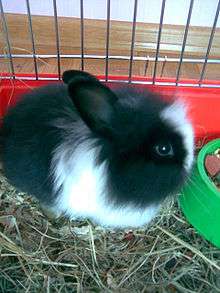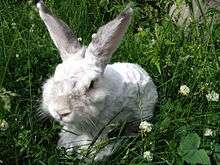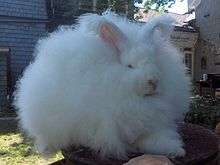Angora rabbit
 Black and white Angora rabbit in cage | |
| Country of origin |
|
|---|---|
| Type | English, French, Giant, Satin, German, Chinese, Swiss, Finnish, Korean, St. Lucian |
| Traits | |
| Weight | Male: English: 2.0–3.5 kg (4.4–7.7 lb) French: 3.5–4.5 kg (7.7–9.9 lb) Satin: 3.0–4.5 kg (6.6–9.9 lb) Giant: 12 lb – 5.5kg or larger |
| Female: English: 2.0–3.5 kg (4.4–7.7 lb) French: 3.5–4.5 kg (7.7–9.9 lb) Satin: 3.0–4.5 kg (6.6–9.9 lb) Giant: 12 lb – 5.5kg or larger | |
| Coat | Long |
| Wool color | (See 'Color' section) |
| Color | Black, white, light brown |
| Lifespan | 7–12 years |
| Fur type | Fine |
| Distinguishing features | Angora rabbits' fur is combed when it gets thick. The Angora rabbits' fur is used in Angora Wool. They go through a heavy shed every couple months. |
The Angora rabbit (Turkish: Ankara tavşanı) is a variety of domestic rabbit bred for its long, soft wool. The Angora is one of the oldest types of domestic rabbit, originating in Ankara (historically known as Angora), present day Turkey, along with the Angora cat and Angora goat. The rabbits were popular pets with French royalty in the mid-18th century, and spread to other parts of Europe by the end of the century. They first appeared in the United States in the early 20th century. They are bred largely for their long Angora wool, which may be removed by shearing, combing, or plucking. There are many individual breeds of Angora rabbits, four of which are recognized by American Rabbit Breeders' Association (ARBA); they are English, French, Giant, and Satin. Other breeds include German, Chinese, Swiss, Finnish, Korean, and St. Lucian.
Coat and appearance

Angoras are bred mainly for their wool, which is silky and soft. At only 11 microns in diameter it is finer and softer than cashmere. Most Angora rabbits are calm and docile, but should be handled carefully. Grooming is necessary to prevent the fiber from matting and felting on the rabbit. A condition, wool block, is common in Angora rabbits, and should be treated quickly.[1] These rabbits are shorn every three to four months throughout the year.
Diet and wool block
As with all rabbits, abundant and unlimited hay should be provided. The fiber the rabbit gains from the hay helps prevent wool block (also referred to as intestinal impaction).[2] It is also recommended particularly for Angora and other long-haired rabbit species that any pellet diets have at least 13% fiber. Fiber content can be found in the nutritional analysis on the food bag.[2] Additionally fecal impaction can be caused by dehydration, which can be prevented by providing unlimited water as well as a salt lick to encourage drinking water.[3]
Since rabbits ingest their wool when they groom themselves, clipping their wool at least once every 90 days is considered a must to prevent wool block from occurring. A dietary supplement of papaya (from the vitamin section of the grocery store) in their diet helps wool to break down in their digestive tract. The wool swallowed by a rabbit cannot be coughed or vomited up, and will cause it to slowly starve to death as its digestive tract fills up with ingested wool; if left untreated, wool block can lead to death. It is widely held among serious Angora breeders that ample cage space to exercise and feeding fresh, horse-quality hay on a daily basis will help keep the wool moving through the system and prevent wool block. It is also widely held that feeding both bromelain from fresh pineapple and papain from fresh papaya occasionally will aid in breaking down the ingested wool (they are proteolytic enzymes), and aid in its passage through the rabbits' system. Another helpful tip for loose wool control includes giving the rabbit a pine cone to play with. They nibble them, throw them around, and they turn into a good wool catcher in their cage. When the pine cone is all nibbled or full of wool, replace it.
Medical considerations
Rabbits do not possess the same allergy-causing qualities as many other animals. The average rabbit can live for about 7–12 years when kept indoors and well-cared for. However, many outdoor rabbits have a shorter lifespan. Maintenance is a must. The Satin Angora has a much lower guard hair count and their wool becomes easily tangled. Regardless of breed, all Angoras must be monitored to prevent wool block, a potentially lethal condition where their digestive tracts become clogged with hair. Proper diet is also crucial in lowering their susceptibility to the block.[4]
Breeds
There are four different breeds recognized by the American Rabbit Breeders' Association (ARBA): English, French, Giant, and Satin. The German Angora is also common, but is not recognized by the ARBA; it has its own association, the IAGARB.
English

- Weight: 2.0–3.5 kg (4.4–7.7 lb).
- ARBA-accepted varieties: ruby-eye white, pointed white, self, shaded, agouti, broken
Prior to 1939, there was one breed of "Angora Wooler". In 1939 ARBA reclassified "Angora Wooler" into "English Type" and "French Type". In 1944 ARBA officially separated Angora rabbits into two breeds: English Angora and French Angora.
Rabbits of the Angora breed are adorned with "fur", growths of wool on the ears and the entire face except above the nose, and front feet, along with their thick body, and wool. They are gentle in nature, but they are not recommended for those who do not groom their animals. Their wool is very dense and needs to be groomed twice a week.
This is the smallest Angora rabbit of the four ARBA-recognized breeds. This breed is more common as a pet because of the facial features that give it a puppy dog or teddy bear look. If the texture of the wool is correct, the maintenance is relatively easy; if the texture of the rabbit is cottony, it requires a great deal of maintenance.
The English Angora can be bred to have broken colors—i.e., white with black spots—but this is not accepted by ARBA standards, and would lead to a disqualification when showing the rabbit. When showing an English Angora rabbit, the toenails should also be only one color, the ears could be folded over at the tips, and the furnishings on the face may cover their eyes. The English Angora rabbit is the only rabbit that has hair covering its eyes.
French

- Weight: 3.5–4.5 kg (7.7–9.9 lb).
- ARBA-accepted varieties: agouti, pointed white, self, shaded, ticked, wide band, also it can be brown tones, and broken
This breed has a big under coat. If the texture is correct, it requires less maintenance than other Angora breeds. Small ear tufts are allowed, but not usually preferred by breeders. ARBA recognizes the same colors as with English Angora, plus broken. They are shown at ARBA shows using the types "white" and "colored" (broken being a colored). As with other ARBA shown rabbits, toenails should also be only one color.
The French Angora is one of the large Angora breeds at 7.5 to 10 lbs, with a commercial body type. It differs from the English, Giant and German Angora in that it possesses a clean (hairless) face and front feet, with only minor tufting on the rear legs. The color of a French Angora is determined by the color of its head, feet and tail (all the same color). This variety of angora fibre has smooth silky texture making it difficult to spin. Desirable characteristics of the fibre include its texture, warmth, light weight, and pure white color. It is used for sweaters, mittens, baby clothes and millinery.
Giant

- Weight: 12 lb – 5.5 kg or larger
- ARBA-accepted varieties: ruby-eyed white
The Giant Angora is the largest of the ARBA accepted Angora breeds, having been created by Louise Walsh, of Taunton, Massachusetts to be an efficient wool-producing rabbit sustained with 16-18% alfalfa based rabbit feed and hay, and living in the standard size all wire cages used for commercial breeds. The ARBA wouldn't allow German angoras to be shown because their body type was too similar to other breeds, so Louise Walsh made a new breed from German angoras, French lops, and Flemish giants to create a completely different body type. After several years the ARBA accepted it as a breed and it is now showable. Its coat contains three types of wool: soft under wool, awn fluff, and awn hair; the awn type wool exists only on the Giant and German Angora. This breed should have furnishings on the face and ears. Many people confuse German with Giant Angora, but they are not the same. Technically one could show a German angora as a Giant angora since they have German angoras in their pedigrees, however they are unlikely to score well due to the lack of desired body shape.
This is the largest of the four ARBA recognized Angora breeds. The only color the ARBA currently officially recognizes for Giant Angora is ruby-eyed white (REW), or as more commonly referred to as an "albino", indicating the absence of color pigment in the genetic makeup. The Giant Angora produces more wool than the French, Satin or English Angora. It is easiest to set the rabbit on a standard grooming table, with a "turn table" to do the clipping, or you can pluck the loose fur they are shedding. The Giant Angora Buck in this picture is on a turn table, about to have his summer clipping, (18 oz) You then stay in control of where the rabbit is. Like the German Angora, they require their wool to be harvested every 90 days. When Giants are on a good feeding program, their wool will grow about 3 cm or 1 inch per month. The coat needs to be monitored after 6 months of growth as it may tend to "die" and easily mat. 12+ ounces of wool is not uncommon per clipping of a good-sized Giant Angora.
The Giant Angora is the only 6-class animal in the Angora breed. It is to have a commercial-type body with a very dense coat of wool. The head will be oval in appearance that is broad across the forehead and slightly narrower at the muzzle. The Giant Angora will have forehead tufts (head trimmings) and cheek furnishings. The head trimmings are to be noticeable, however, does are not as heavy in trimmings as the bucks. The ears should be lightly fringed and well tasseled. The Giant Angora is also the only breed of angora that is only shown as a ruby-eyed white. The Black Giant Angora is in development, but has not been sanctioned by ARBA.[5]
The Giant Angora coat contains three fiber types for its texture. The underwool is to be the most dominant over the other two types of hair. It should be medium fine, soft, delicately waved and have a gentle shine. The Awn Fluff has a guard hair tip and is a stronger, wavy wool. The Awn Fluff is found between the Underwool and Awn Hair. The Awn Hair, also known as guard hair, is the third type of fiber. The Awn Hair is a straight, strong hair that protrudes above the wool and must be present and evident.
The classification of the Giant Angora is different than the other three breeds due to the fact it is a 6-class animal. The junior buck and junior doe must be under 6 months of age and have a minimum weight of 4 ¾ pounds. The intermediate buck and intermediate doe are 6–8 months of age. The senior buck and senior doe are 8 months of age or over. The senior buck must weigh at least 9 ½ pounds. The senior doe must weigh at least 10 pounds.
In judging the Giant Angoras the majority of the points are based on the wool, which includes density, texture, and length. The points for "general type" include the body type, head, ears, eyes, feet, legs, and tail.
Additional information may be found in the ARBA Standard of Perfection
Like many other "giant" breeds of rabbits, the Giant Angora grows slowly. A doe usually takes more than a year to reach full maturity (size and weight). A buck can take up to 1.5 years to fully mature (size and weight).
Satin

- Weight: 3.0–4.5 kg (6.6–9.9 lb).
- ARBA-accepted varieties: agouti, pointed white, self, shaded, sicked, wide band
The Satin Angora is derived from cross breeding between a Satin and a French Angora. This breed is named for the high sheen of the wool, commonly referred to as "satinized", the hair shaft has a semi-transparent outer shell and reflects light, resulting in deep color, high luster, and extreme soft texture of its wool. It resembles the French Angora, having no furnishings on the face, ears, or feet, and it is also easy to groom compared to the English variety, although the soft texture makes matting an issue, and daily combing is recommended. Satin Angora's wool is said to be stronger for spinning than other varieties of Angora, although it is considered more difficult to spin as it is more slippery.

They are shown at ARBA shows using the types "white" and "colored" (broken not yet approved). As with other ARBA shown rabbits, toenails should also be only one color. The color of a Satin Angora is determined by the color of its head, feet, and tail (all the same color).
This breed does not produce as much wool as other breeds of Angora rabbits. This trait is being improved upon by selective breeding. The wool should have a silky texture, high luster, with good guard hair for ease of maintenance.
See also
References
- ↑ "Angora Rabbit Breeds – How to Care for Your Angora Rabbit". Archived from the original on 25 January 2009. Retrieved 2009-01-29.
- 1 2 "Natural Nutrition I: The Importance of Fiber". Retrieved 2011-02-12.
- ↑ "Stopping that Wascalwy Rabbit". Retrieved 2011-02-12.
- ↑ What is Wool Block
- ↑ Summary on the description of a Giant Angora, American Rabbit Breeders Association, Standards, spring 2012.
External links
- Angora Gardens – has a Primer on Angora Rabbit care
- Angora Breeder Exhibitor in the UK
- National Angora Rabbit Breeders Club official site
- German Angora information, pictures, links to sites in Germany
- Home of Grand Champions Information on breeding, caring for, and showing Angora rabbits, as well as an extensive photo gallery
- Spang Angoras Information on the French Angora rabbits
- French Angora Rabbit Breed History
- International Association of German Angora Rabbit Breeders official site
- German, Giant and French Angora rabbit information, photos, educational and health articles Angora wool for use in fiber arts, step by step how to spin Angora into yarn, links
- Angora Rabbit care information and forum.
- English Angora Rabbit Breed History